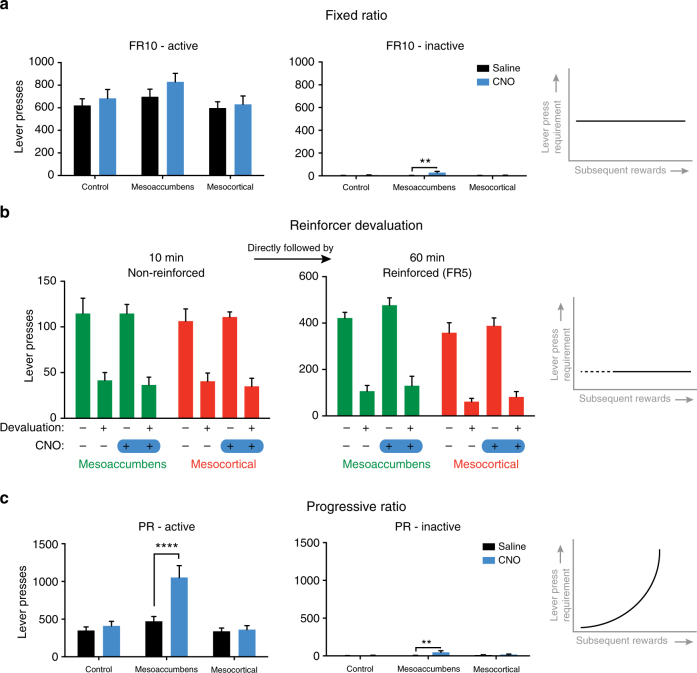Fig. 5.
Mesocortical and mesoaccumbens activation does not alter the static reward value of sucrose. a DREADD activation of either pathway did not affect the number of active lever presses under an FR10 schedule of reinforcement (two-way repeated ANOVA; effect of CNO, p = 0.0355; group×CNO effect, p = 0.5001; post-hoc test, CNO versus saline, all p > 0.1). A modest increase was observed in inactive lever presses after mesoaccumbens activation (two-way ANOVA; effect of CNO, p = 0.0096; group×CNO effect, p = 0.0207; post-hoc test, CNO versus saline, p = 0.9302 controls, p = 0.0017 mesoaccumbens group; p = 0.9957 mesocortical group); n = 9 for control, n = 8 for mesoaccumbens, n = 9 for mesocortical. b Both during a 10 min extinction session (left) and a reinforced lever pressing session (FR5, right), devaluation of the reinforcer by selective satiation for sucrose lead to a decrease in responding (2-way ANOVA, effect of prefeeding in all groups, p < 0.0001), without any CNO effects (non-reinforced mesoaccumbens, CNO effect p = 0.7745, prefeeding×CNO effect: p = 0.8448; non-reinforced, mesocortical, CNO effect p = 0.9516, prefeeding×CNO effect: p = 0.5318; reinforced mesoaccumbens, CNO effect p = 0.1472, prefeeding×CNO effect: p = 0.5287; reinforced mesocortical, CNO effect p = 0.4654, prefeeding×CNO effect: p = 0.8877); n = 12 mesoaccumbens, n = 11 mesocortical group. c Under a progressive ratio schedule of reinforcement, mesoaccumbens activation increased the number of lever presses made (two-way ANOVA; effect of CNO, p = 0.0006; group×CNO effect, p = 0.0007; post-hoc test, p = 0.8998 controls; p < 0.0001 mesoaccumbens group; p = 0.9947 mesocortical group). A modest increase in inactive lever presses was observed after mesoaccumbens stimulation (two-way ANOVA; effect of CNO, p = 0.0204; group×CNO effect, p = 0.0680; post-hoc test, CNO versus saline, p = 0.9840 controls; p = 0.0082 mesoaccumbens group; p = 0.9392 mesocortical group); n = 9 controls, n = 8 mesoaccumbens group, n = 9 mesocortical group. Data shown as mean ± standard error of the mean; **p < 0.01, ****p < 0.0001

